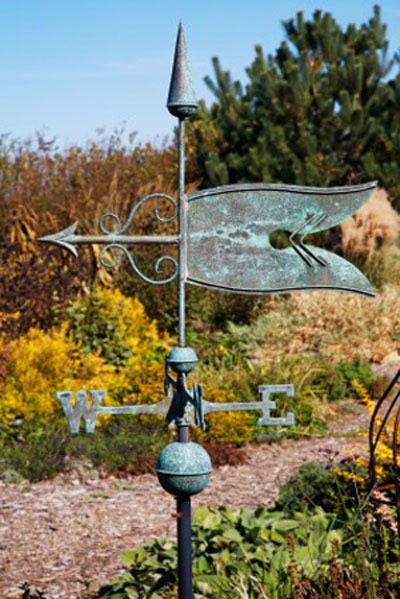
Since ancient times, weathervanes have been used to help understand and forecast the weather. Today, they are a fun and functional way to bring a personal touch to your home and garden. Whether you choose a weathervane that depicts traditional old world style, or a whimsical design that reflects your personal interests, a weathervane is a great way to make an eye-catching statement.
When you pick a weathervane for your garden, it should be made of a material that complements your garden, and have a design that fits your style.
Style: From dog breeds and birds in flight, to farm animals, ships and mythological creatures, you can find a weathervane for just about any garden theme. Copper weathervanes are popular, because with each passing year the copper gathers more patina and giving them a look of old-world charm. Other common materials include painted or unpainted steel, aluminum, and vinyl.
Size: One of the most important things to consider when selecting a weathervane for your garden is the size. Will it be mounted on a post in the ground, or adorn the top of your garden shed? In either case, keep in mind that weathervanes appear smaller in size as you move away from them. As a general rule, roof mounted weathervanes tend to be larger in size than those mounted closer to the ground.
Cupolas: Most "garden" weathervanes are designed to be mounted on a post and stuck into the ground. If you plan to mount your weathervane on top of a roof, the addition of a cupola can really make it stand out. Years ago, cupolas were designed to ventilate and provide light to barns and other buildings. Today they are primarily used to as "roof jewels", a rustic accent to compliment homes and weathervanes.
Wind cup weathervanes: This style of weathervane has small wind cups located between the ornamental figure and the directional arrows that spin around freely even in the slightest breeze. With a wind cup weathervane, you get a lot of movement. You can not only see which direction the wind is blowing, but also how hard it is blowing.
If your weathervane is purely for decorative purposes, place it anywhere in the garden where you think it will achieve the best affect. A height of slightly above eye level will allow you to see it easily, but without the strain of constantly looking up. If you want your weathervane to be both ornamental and still obtain an accurate wind direction reading, you need to mount it well above the ground (at least 6 to 7 feet) and in an open area away from buildings, trees, and other objects which might interfere with the true direction of the wind.
Wind direction changes often accompany changes in the weather. Exactly what type of weather the wind brings depends a lot on what type of environment (ocean, desert, mountains, plains, etc.) exists in every direction near your location.

About The Author: Ellen Brown is an environmental writer and photographer and the owner of Sustainable Media, an environmental media company that specializes in helping businesses and organizations promote eco-friendly products and services.
Add your voice! Click below to comment. ThriftyFun is powered by your wisdom!